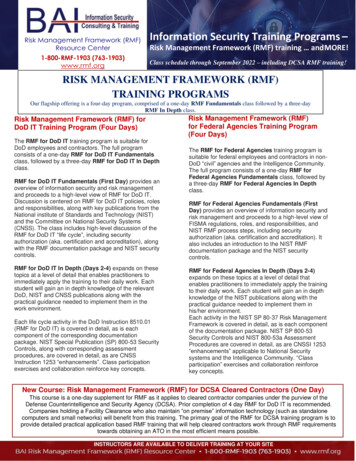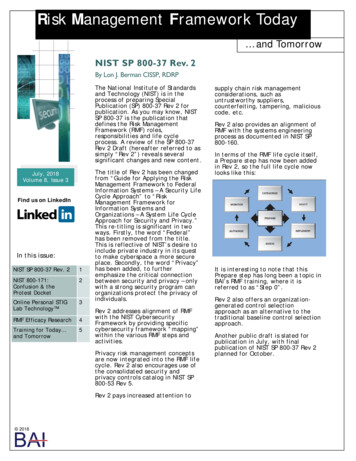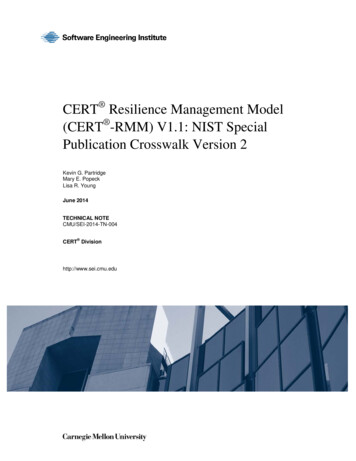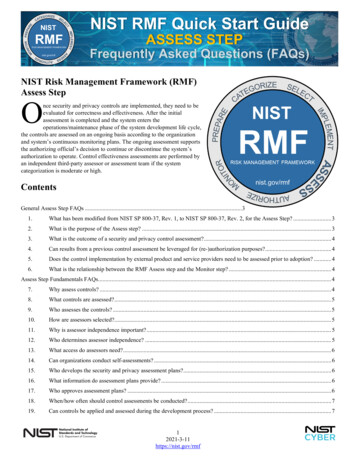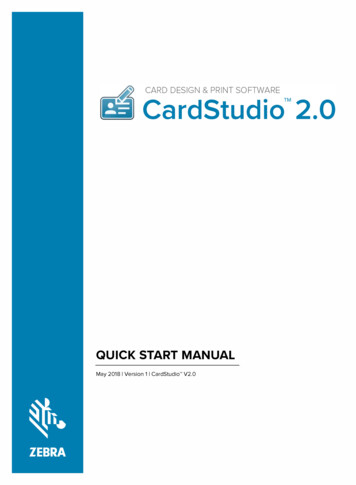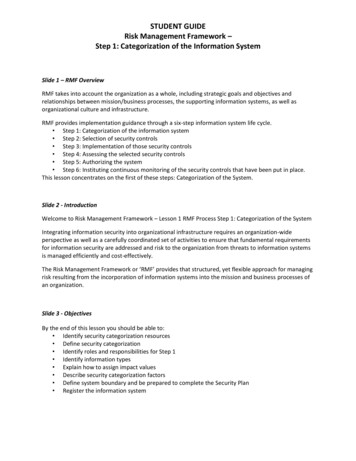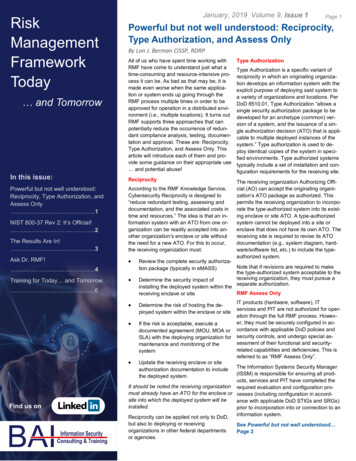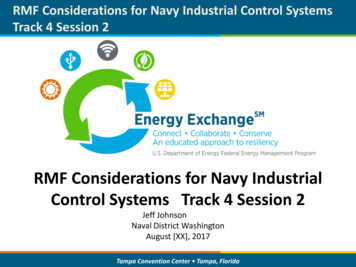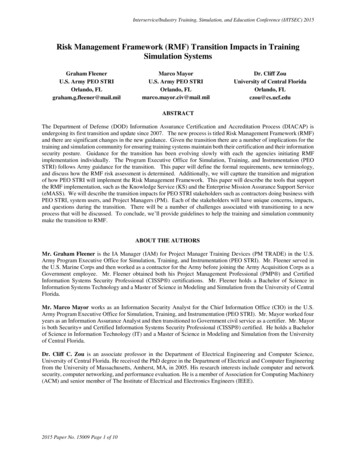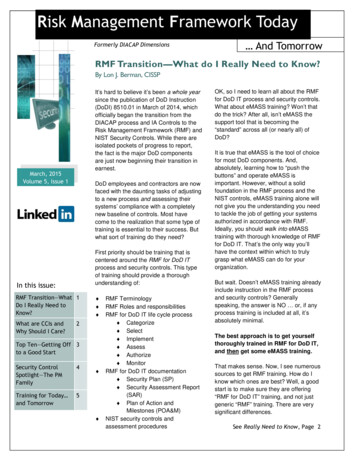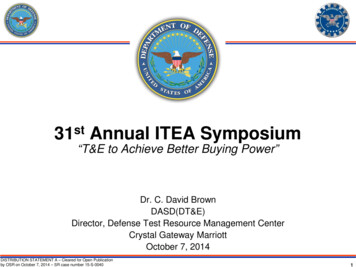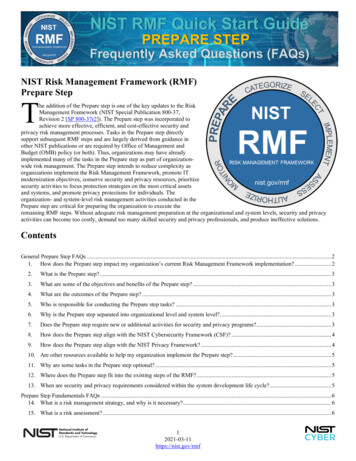
Transcription
NISTRMFRISK MANAGEMENT FRAMEWORKnist.gov/rmfNIST RMF Quick Start GuidePREPARE STEPFrequently Asked Questions (FAQs)NIST Risk Management Framework (RMF)Prepare StepThe addition of the Prepare step is one of the key updates to the RiskManagement Framework (NIST Special Publication 800-37,Revision 2 [SP 800-37r2]). The Prepare step was incorporated toachieve more effective, efficient, and cost-effective security andprivacy risk management processes. Tasks in the Prepare step directlysupport subsequent RMF steps and are largely derived from guidance inother NIST publications or are required by Office of Management andBudget (OMB) policy (or both). Thus, organizations may have alreadyimplemented many of the tasks in the Prepare step as part of organizationwide risk management. The Prepare step intends to reduce complexity asorganizations implement the Risk Management Framework, promote ITmodernization objectives, conserve security and privacy resources, prioritizesecurity activities to focus protection strategies on the most critical assetsand systems, and promote privacy protections for individuals. Theorganization- and system-level risk management activities conducted in thePrepare step are critical for preparing the organization to execute theremaining RMF steps. Without adequate risk management preparation at the organizational and system levels, security and privacyactivities can become too costly, demand too many skilled security and privacy professionals, and produce ineffective solutions.ContentsGeneral Prepare Step FAQs . 21. How does the Prepare step impact my organization’s current Risk Management Framework implementation? . 22.What is the Prepare step? . 33.What are some of the objectives and benefits of the Prepare step? . 34.What are the outcomes of the Prepare step? . 35.Who is responsible for conducting the Prepare step tasks? . 36.Why is the Prepare step separated into organizational level and system level? . 37.Does the Prepare step require new or additional activities for security and privacy programs? . 38.How does the Prepare step align with the NIST Cybersecurity Framework (CSF)? . 49.How does the Prepare step align with the NIST Privacy Framework? . 410. Are other resources available to help my organization implement the Prepare step? . 511. Why are some tasks in the Prepare step optional? . 512. Where does the Prepare step fit into the existing steps of the RMF? . 513. When are security and privacy requirements considered within the system development life cycle? . 5Prepare Step Fundamentals FAQs . 614. What is a risk management strategy, and why is it necessary? . 615. What is a risk assessment? . 612021-03-11https://nist.gov/rmf
NISTRMFRISK MANAGEMENT FRAMEWORKnist.gov/rmfNIST RMF Quick Start GuidePREPARE STEPFrequently Asked Questions (FAQs)16. What is a Cybersecurity Framework or Privacy Framework profile?. 617. What is a common control? . 718. How are common controls determined for the organization? . 719. Who should define common controls?. 720. What is an enterprise architecture? . 821. What is the difference between security and privacy requirements and security and privacy controls? . 822. What is an authorization boundary?. 823. Is the authorization boundary the same as a system boundary? . 824. When should the authorization boundary be established? . 925. Who is responsible for establishing the authorization boundary?. 926. How is the authorization boundary established?. 927. What are the various types of information that government systems process? . 10Organizational Support for the Prepare Step FAQs . 1128. How do organizations establish mission-based information types?. 1129. What are key organizational roles and responsibilities in the Prepare step? . 1130. What is an organizationally tailored control baseline? . 1131. What is the source of the new tasks in the Prepare step – Organizational Level? . 12System-specific Application of the Prepare Step FAQs . 1232. Why was the authorization boundary task added? . 1233. What is the information life cycle? . 1234. What is system registration? . 1235. What is the source of the new tasks in the Prepare step – System Level? . 12References. 13General Prepare Step FAQs1. How does the Prepare step impact my organization’s current Risk Management Frameworkimplementation?The Prepare step is not intended to require new or additional activities for security and privacy programs. Rather, it emphasizes theimportance of having comprehensive, organization-wide governance and the appropriate resources in place to enable the execution ofcost-effective and consistent risk management processes across the organization. Most tasks included in the Prepare step are derivedfrom existing NIST guidance and/or OMB policy requirements and are foundational activities that support the implementation ofsubsequent Risk Management Framework steps. [Back to Table of Contents]22021-03-11https://nist.gov/rmf
NISTRMFRISK MANAGEMENT FRAMEWORKnist.gov/rmfNIST RMF Quick Start GuidePREPARE STEPFrequently Asked Questions (FAQs)2. What is the Prepare step?The purpose of the Prepare step is to carry out essential risk management tasks at the organization, mission and business process, andsystem levels to establish context and help prepare the organization to manage its security and privacy risks using the RiskManagement Framework. Prepare step tasks are completed before the Categorize step and support all subsequent Risk ManagementFramework steps and tasks. Ultimately, the intention of the Prepare step is to provide the information and resources necessary tosuccessfully manage information security and privacy risk to the organization and its missions from the operation and use of systems.[Back to Table of Contents]3. What are some of the objectives and benefits of the Prepare step?The objectives and benefits of the Prepare step include: Facilitating better communication between senior leaders and executives at the organization and mission and businessprocess levels and system owners Facilitating organization-wide identification of common controls and the development of organizationally tailored controlbaselines, reducing the workload on individual system owners and the cost of system development and asset protection Reducing the complexity of the information technology and operations technology infrastructure using enterprise architectureconcepts and models to consolidate, optimize, and standardize organizational systems, applications, and services Identifying, prioritizing, and focusing resources on the organization’s high-value assets and high impact systems that requireincreased levels of protection and taking steps commensurate with the risk to such assets. [Back to Table of Contents]4. What are the outcomes of the Prepare step?An outcome is a result of a specific task identified in NIST SP 800-37 [SP 800-37r2]. For a listing of outcomes for each task in thePrepare step, refer to Table 1: Prepare Tasks and Outcomes – Organization Level and Table 2: Prepare Tasks and Outcomes – SystemLevel. [Back to Table of Contents]5. Who is responsible for conducting the Prepare step tasks?Each task in the Prepare step identifies the primary role(s) responsible for ensuring the implementation and completion of the task, aswell as supporting roles to assist or provide guidance or expertise for task implementation. Refer to the RMF Roles andResponsibilities Crosswalk chart for roles and responsibilities associated with the Prepare step tasks. For a description of roles andtheir associated responsibilities, see Appendix D: Roles and Responsibilities. [Back to Table of Contents]6. Why is the Prepare step separated into organizational level and system level?The preparatory activities are grouped into organization-level preparation and system-level preparation for ease of use and to clarifyappropriate roles and responsibilities. [Back to Table of Contents]7. Does the Prepare step require new or additional activities for security and privacy programs?No, the Prepare step tasks are based on existing OMB policy requirements and risk management-related guidance from other NISTpublications, including NIST SP 800-30 [SP 800-30], NIST SP 800-39 [SP 800-39], NIST SP 800-137 [SP 800-137], NIST SP 800160 [SP 800-160], and NISTIR 8062 [IR 8062]. Each task in the Prepare step includes specific references to the task source andsupporting publication. [Back to Table of Contents]32021-03-11https://nist.gov/rmf
NISTRMFRISK MANAGEMENT FRAMEWORKnist.gov/rmfNIST RMF Quick Start GuidePREPARE STEPFrequently Asked Questions (FAQs)8. How does the Prepare step align with the NIST Cybersecurity Framework (CSF)?To ensure effective and efficient Cybersecurity Framework implementation, several key areas within the RMF have been updated.Each task in the RMF includes references to applicable sections of the Cybersecurity Framework. For example, RMF Prepare –Organization Level step, Task P-2, Risk Management Strategy, aligns with the Cybersecurity Framework Core [Identify Function];RMF Prepare—Organization Level step, Task P-4, Organizationally-Tailored Control Baselines and Cybersecurity FrameworkProfiles, aligns with the construct of Cybersecurity Framework Profiles. [Back to Table of Contents]9. How does the Prepare step align with the NIST Privacy Framework?The NIST Privacy Framework: A Tool for Improving Privacy through Enterprise Risk Management [NIST PF] provides a simple“ready, set, go” method for establishing or improving a privacy program. The objective of its “Ready” phase may be compared to theRMF’s Prepare step objective in assisting organizations with setting the groundwork for subsequent tasks andCategories/Subcategories to support their risk management processes. Some of the tasks in the Prepare step support certain outcomesin the NIST Privacy Framework and vice versa. The following table provides a mapping between Prepare step tasks and PrivacyFramework Categories/Subcategories. For the complete mapping of SP 800-37, Revision 2, to the Privacy Framework, visit thePrivacy Framework Resource Repository at pository. [Back to Table of Contents]NIST SP 800-37 Prepare Step TasksTask P-1, Risk Management RolesNIST Privacy Framework Categories/SubcategoriesGovernance Policies, Processes, and Procedures (GV.PO-P3 andGV.PO-P4)Awareness and Training (GV.AT-P2 and GV.AT-P3)Communication Policies, Processes, and Procedures (CM.PO-P2)Risk Management Strategy (GV.RM-P)Data Processing Ecosystem Risk Management (ID.DE-P1)Risk Assessment (ID.RA-P)Monitoring and Review (GV.MT-P1)Task P-2, Risk Management StrategyTask P-3, Risk Assessment – OrganizationTask P-4 (optional), Organizationally Tailored ControlBaselines and Cybersecurity Framework ProfilesTask P-5, Common Control IdentificationTask P-6 (Optional), Impact-Level PrioritizationTask P-7, Continuous Monitoring Strategy – OrganizationTask P-8, Mission or Business FocusTask P-9, System StakeholdersTask P-10, Asset IdentificationTask P-11, Authorization BoundaryTask P-12, Information TypesTask P-13, Information Life CycleTask P-14, Risk Assessment – SystemTask P-15, Requirements DefinitionTask P-16, Enterprise ArchitectureTask P-17, Requirements AllocationTask P-18, System RegistrationGovernance Policies, Processes, and Procedures (GV.PO-P5)(none)(none)(none)Business Environment (ID.BE-P2 and ID.BE-P3)Inventory and Mapping (ID.IM-P2)Business Environment (ID.BE-P1)Risk Assessment (ID.RA-P1 and ID.RA-P2)Inventory and Mapping (ID.IM-P1 and ID.IM-P2)(none)Inventory and Mapping (ID.IM-P6)Inventory and Mapping (ID.IM-P4 , ID.IM-P5, and ID.IM-P8)Data Processing Policies, Processes, and Procedures (GV.PO-P5 andGV.PO-P6)Risk Assessment (ID.RA-P4 and ID.RA-P5)Monitoring and Review (GV.MT-P1)Governance Policies, Processes, and Procedures (GV.PO-P5 andGV.PO-P6)Inventory and Mapping (ID.IM-P7)Governance Policies, Processes, and Procedures rmf
NISTRMFRISK MANAGEMENT FRAMEWORKnist.gov/rmfNIST RMF Quick Start GuidePREPARE STEPFrequently Asked Questions (FAQs)10. Are other resources available to help my organization implement the Prepare step?Each task in the Prepare step includes references to relevant supporting publications that provide additional guidance for taskcompletion. Refer to the NIST FISMA Implementation Project website (https://nist.gov/rmf) for additional resources. [Back to Tableof Contents]11. Why are some tasks in the Prepare step optional?Prepare Task P-4, Organizationally Tailored Control Baselines and Cybersecurity Framework Profiles, and Task P-6, Impact-LevelPrioritization, are optional. Organizational level Task P-4 is optional because organizations determine the applicability and need forspecialized sets of controls (e.g., tailored control baselines) for organization-wide use. Organizations can, at their discretion, use thetailored control baseline concept when there is divergence from the fundamental assumptions used to create the initial controlbaselines in NIST Special Publication 800-53B [SP 800-53B]. This would include, for example, situations when the organization hasspecific security and privacy risks, specific mission or business needs, or plans to operate in environments that are not addressed in theinitial baselines. Organizationally tailored control baselines can also be developed to streamline the tailoring process across theorganization. For example, an organization could develop a tailored baseline that applies to all moderate impact applications withinthe organization. Organizational level Task P-6 is optional because organizations may determine that additional granularity in theirimpact designations facilitates risk-based decision making, including the allocation of resources. Organizations can use organizationallevel task P-6 to prioritize systems within each impact level. For example, an organization may want to prioritize moderate impactsystems by assigning each moderate impact system to one of three more granular moderate impact level subcategories: low-moderatesystems, moderate-moderate systems, and high-moderate systems. [Back to Table of Contents]12. Where does the Prepare step fit into the existing steps of the RMF?The Prepare step should be completed before the remaining steps or tasks are undertaken since its tasks support subsequent tasks.Organizations implementing the Risk Management Framework for the first time typically carry out the steps in sequential order,starting with the Prepare step. If the system is already in the operations and maintenance phase of the system development life cycle aspart of the continuous monitoring step, Prepare step tasks still need to be undertaken for effective risk management. The idea is toensure that Prepare step tasks are performed even by systems in operations. [Back to Table of Contents]13. When are security and privacy requirements considered within the system development lifecycle?All federal systems – including operational systems, systems under development, and systems undergoing modifications or upgrades –are in some phase of a system development life cycle. Requirements definition is a critical part of any system development processand begins very early in the life cycle, typically in the initiation phase. Security and privacy requirements are a subset of the overallfunctional and nonfunctional requirements levied on a system and are incorporated into the system development life cyclesimultaneously with the functional and nonfunctional requirements. Without the early integration of security and privacyrequirements, significant expenses may be incurred by the organization later in the life cycle to address security and privacyconsiderations that could have been included in the initial design. When security and privacy requirements are considered as anintegral subset of other system requirements, the resulting system has fewer weaknesses and, therefore, fewer vulnerabilities that canbe exploited in the future. [Back to Table of Contents]52021-03-11https://nist.gov/rmf
NISTRMFRISK MANAGEMENT FRAMEWORKnist.gov/rmfNIST RMF Quick Start GuidePREPARE STEPFrequently Asked Questions (FAQs)Prepare Step Fundamentals FAQs14. What is a risk management strategy, and why is it necessary?The risk management strategy guides and informs risk-based decisions, including how security and privacy risk is framed, assessed,responded to, and monitored. The risk management strategy makes explicit the threats, assumptions, constraints, priorities, trade-offs,and risk tolerance used for making investment and operational decisions. The strategy includes the strategic-level decisions andconsiderations for how senior leaders and executives are to manage security, privacy, and supply chain risks to organizationaloperations and assets, individuals, other organizations, and the Nation. The risk management strategy includes an expression oforganizational risk tolerance; acceptable risk assessment methodologies and risk response strategies; a process for consistentlyevaluating the security, 1 privacy, 2 and supply chain 3 risks across the organization with respect to risk tolerance; and approaches formonitoring risk over time. Security risk management strategy is addressed in NIST SP 800-39 [SP 800-39]. Foundational privacy riskmanagement concepts and considerations that can inform organizations’ strategies are provided in NISTIR 8062 [IR 8062]. Supplychain risk management strategy is addressed in NIST SP 800-161 [SP 800-161]. [Back to Table of Contents]15. What is a risk assessment?Assessing risk is one of the four components of risk management addressed in the organization’s risk management strategy. Riskassessments are used to identify, estimate, and prioritize risk to organizational operations (i.e., mission, functions, image, andreputation), organizational assets, individuals, other organizations, and the Nation, resulting from the operation and use of systems.The purpose of security risk assessments is to inform decision makers and support risk responses by identifying (i) relevant threats toorganizations or threats directed through organizations against other organizations; (ii) vulnerabilities, both internal and external toorganizations; (iii) impact (i.e., harm) to organizations that may occur given the potential for threats exploiting vulnerabilities; and (iv)the likelihood that harm will occur. The end result is a determination of risk (i.e., typically a function of the degree of harm andlikelihood of harm occurring). NIST SP 800-30 [SP 800-30] provides guidance on conducting risk assessments. Privacy riskassessments are conducted to determine the likelihood that a given operation the system is taking when processing PII could create anadverse effect on individuals and the potential impact on those individuals. NISTIR 8062 [IR 8062] introduces privacy riskmanagement and a privacy risk model for privacy risk assessments. Organizations can use the NIST Privacy Risk AssessmentMethodology (PRAM) tool to apply the risk model from NISTIR 8062 and analyze, assess, and prioritize privacy risks. [Back to Tableof Contents]16. What is a Cybersecurity Framework or Privacy Framework profile?A Profile is a selection of outcomes from the Cybersecurity Framework or Privacy Framework Core based on mission and businessfunctions, security and privacy requirements, and risk determinations. Many of the tasks in the organizational preparation step providean organization-level view of these considerations (i.e., functions, security and privacy requirements, and risk determinations) and canserve as inputs to a Profile. The resulting prioritized list of cybersecurity and privacy outcomes developed at the organization andmission and business process levels can be helpful in facilitating consistent, risk-based decisions at the system level during theexecution of the RMF steps. Profiles can also be used to guide and inform the development of the tailored control baselines describedin NIST SP 800-37 [SP 800-37r2] and NIST SP 800-53B [SP 800-53B]. For more information about the Cybersecurity Framework,see [NIST CSF]. For more information about the Privacy Framework, see [NIST PF]. [Back to Table of Contents]Security risk management strategy is addressed in NIST SP 800-39 [SP 800-39].Privacy risk management strategy is addressed in NISTIR 8062 [IR 8062].3 Supply chain risk management strategy is addressed in NIST SP 800-161 [SP 800-161].1262021-03-11https://nist.gov/rmf
NISTRMFRISK MANAGEMENT FRAMEWORKnist.gov/rmfNIST RMF Quick Start GuidePREPARE STEPFrequently Asked Questions (FAQs)17.What is a common control?Controls are safeguards to protect the security of information and systems as well as the privacy of individuals. Common controls arecontrols provided by a system or non-system entity other than the system-of-interest that can be inherited by one or moreorganizational systems. Common controls promote more cost-effective and consistent information security across the organization andcan also simplify risk management activities. These controls can include, for example, physical and environmental protection controls,boundary protection and monitoring controls, personnel security controls, policies and procedures, acquisition controls, account andidentity management controls, audit log and accountability controls, or complaint management controls for receiving privacy-relatedinquiries from the public. Organizations identify and make available to system owners the set of common controls available forinheritance by organizational systems and allocate those controls to the organizational entities designated as common controlproviders for implementation and monitoring.From a system standpoint, inheriting common controls can result in fewer controls to implement (and maintain) and, thus, fewerexpenses. Many common controls, however, are actually hybrid controls in which the organization or system offering the controlsonly provides part of the controls. The system is then responsible for implementing the remaining portion of the common controls.Take, for example, PE-3 PHYSICAL ACCESS CONTROL. A system may be a tenant within a facility managed and operated by aseparate organization responsible for the facility, including controlling access to the facility, but the system may still be responsiblefor the remaining control items that are not offered by the common control provider.Organizations or entities that offer common controls for inheritance need to ensure that control implementation details arecommunicated to inheriting systems and that any additional guidance for implementation are provided (e.g., in the case of hybridcontrols). Such guidance is beneficial to inheriting systems as well as to control assessors. Any changes to control offerings, includinghow common controls are implemented, also need to be communicated. Whether common control providers offer controls to the entireorganization or to specific systems, it is the responsibility and interest of the inheriting system to ensure that it is informed of anychanges to control offerings. There may be cases in which organizations post information on changes to their common controlofferings, and it is up to inheriting systems to respond to such changes.For additional discussion on common controls, see RMF Prepare – Organization Level step, Task P-5, Common ControlIdentification, and NIST SP 800-53 [SP 800-53r5]. [Back to Table of Contents]18. How are common controls determined for the organization?The organization-wide process for determining common controls includes considerations of the security categories and impact levelsof the systems within the organization; legislative, regulatory, or policy requirements; and the controls necessary to adequatelymitigate the security and privacy risks that arise from the use of those systems. When common controls protect multiple organizationalsystems of differing impact levels, the controls are implemented with regard to the highest impact level among the systems. Theallocation of security and privacy requirements to the system and to the environment in which it operates determine which securityand privacy controls are designated as common controls. [Back to Table of Contents]19. Who should define common controls?The identification of common controls is most effectively accomplished as an organization-wide exercise with the active involvementof the senior agency information security officer, senior agency official for privacy, mission or business owner, senior accountableofficial for risk management or risk executive (function), chief information officer, authorizing official or authorizing officialdesignated representative, common control provider, and system owner. [Back to Table of Contents]72021-03-11https://nist.gov/rmf
NISTRMFRISK MANAGEMENT FRAMEWORKnist.gov/rmfNIST RMF Quick Start GuidePREPARE STEPFrequently Asked Questions (FAQs)20. What is an enterprise architecture?Enterprise architecture 4 is a management practice used by organizations to maximize the effectiveness of mission and businessprocesses and information resources and to achieve mission and business success. An enterprise architecture can help provide agreater understanding of information and operational technologies included in the initial design and development of systems andshould be considered a prerequisite for achieving the resiliency and survivability of those systems in the face of increasinglysophisticated threats, as well as for protecting individuals’ privacy in light of increasingly complex data processing. Enterprisearchitecture provides an opportunity for organizations to
https://nist.gov/rmf NIST RMF Quick Start Guide PREPARE STEP nist.gov/rmf Frequently Asked Questions (FAQs)RISK MANAGEMENT FRAMEWORK RMF NIST NIST Risk Management Framework (RMF) Prepare Step . he addition of the Prepare step is one of the key updates to the Risk Management Framework (NIST Special Publication 800-37, Revision 2 [SP 800-37r2]).
